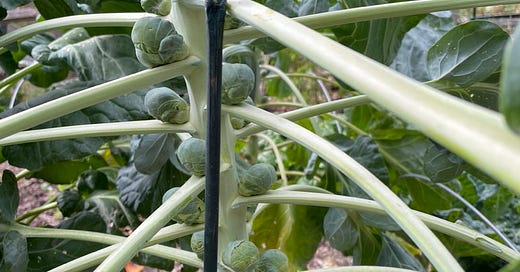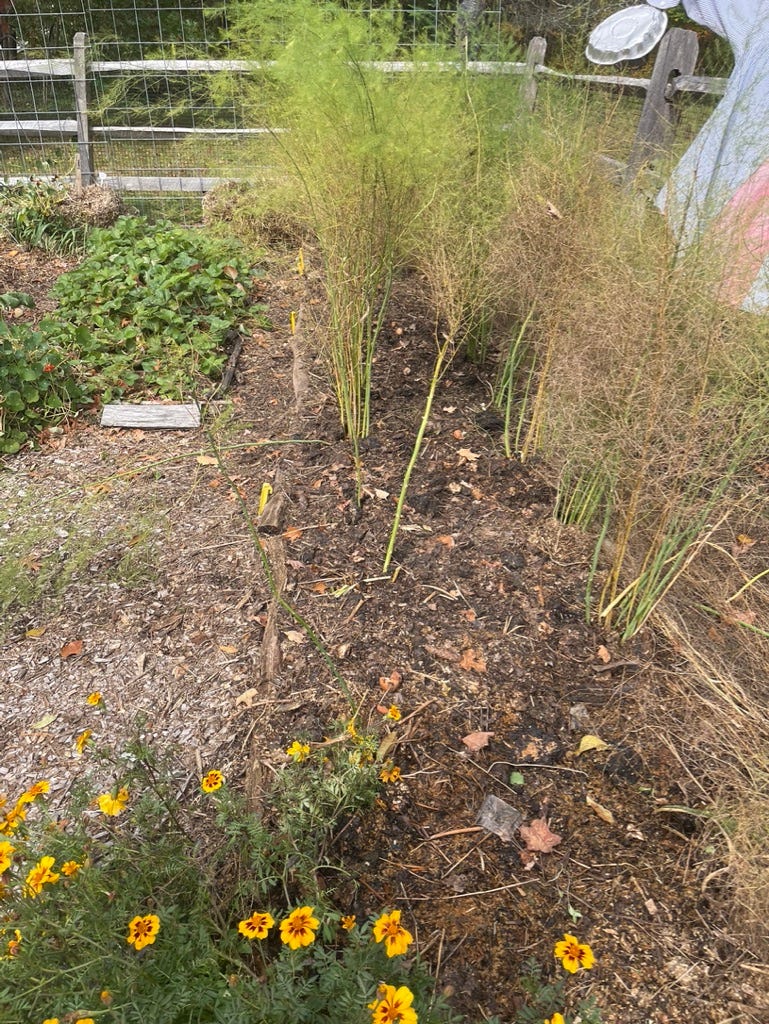What’s happening in the garden this week: Oct. 13-19
The Brussels Sprouts reach a milestone, and we go native
Brussels Sprouts
My first successful effort at growing Brussels Sprouts reached a new milestone. I harvested some! I snapped a couple dozen sprouts off the bottom foot or of two of my plants, removing the leaves as I went. Most were pretty small, but it’s good to harvest the smaller ones at the bottom of the plant so it has more energy available for the larger sprouts growing higher up the stalk.
This has been an interesting journey, maybe only to me, or perhaps those who like Brussels Sprouts. I never really liked Brussels Sprouts until I started pan or oven roasting them. Now they’re one of my favorite vegetables, even more so because they normally don’t start appearing in the markets until late fall and winter.
Anyway, the effort began April 25, when I started two varieties – Gladius and Long Island Improved – in trays under grow lights in our cellar. Three weeks later, I interplanted six small seedlings among rows of spinach I had put into the garden in mid-March. I could have, maybe should have, waited a little longer to let the seedlings mature a bit more before putting them in the ground, but I felt I needed to get them into the bed because Brussels Sprouts take months to grow.
Four days after I planted them, four out of the six plants were gone. I wasn’t sure who got them but I suspect that since they were young and tender they were easy pickings for the slugs that were bedeviling the garden around that time. On May 27 I started more seeds in the cellar. As they sprouted under the lights, I covered the bed in the garden with thin netting to protect the bigger plants from moths and other airborne pests.
In late June I planted three of the seedlings I’d started the previous month, two Gladius and one Long Island Improved. A neighbor took the other seedlings and put them in her garden. I had taken the netting off and within a month discovered the five plants were being devoured by what I identified as cross-striped cabbage worms. These were hideous looking pests that were packed in the plants’ nooks and crannies, merrily munching away. I sprayed the plants with BT, a natural insecticide, and put the cabbage worms to rest. I also staked the plants to keep them from toppling over.
Late in August dozens of little Brussels Sprouts were emerging from where the leaves of the plants meet their long, thick stems. They were about the size of pennies. The plants had grown to nearly five feet tall, so in mid-September I topped them – snipping the top end of the stalk off – to prevent them from growing any taller and to encourage them to devote their energy to the sprouts below.
Brussels Sprouts, like other brassicas like cabbage and kale, actually can improve in flavor after a light frost, which we had this week when the temperatures dropped to about 30 degrees overnight. If all goes well, we should be able to harvest from these plants into the winter.
Asparagus
I started cutting down the dead asparagus stalks, laying them in the adjoining path to serve as mulch. With the bed a little more clear it was a good time to put down a layer of compost on it to revitalize the soil. I’ll likely add an inch or two of shredded leaves on top of the entire bed in a few weeks to protect the asparagus roots through the winter. Hopefully we’ll be seeing tiny stalks emerging next spring.
[Here’s a little something I wrote about the asparagus bed back in the spring.]
Hazelnuts and Native Plants
We had an open space along the split-rail fence that runs between our property and the adjacent Catholic Church, which has been converted into a very cool residence by a Brooklyn sound engineer and his girlfriend. After some research, we decided to plant American hazelnuts along the fence. They are an underused but wonderful bush native to the eastern United States that produce little yellow flowers and long catkins (the female and male parts of the plant) in the spring, followed by small, sweet nuts (hazelnuts) that are prized by squirrels, blue jays, woodpeckers, deer and humans. The leaves turn red and yellow in the fall. The three shrubs we planted should grow to 6-8 feet tall and spread about as much, providing a nice screen along the fence. We’ve been trying to plant native trees and shrubs whenever we have a need for them. So far this year, we’ve planted several chokeberries and elderberries, and a Downy Serviceberry tree in addition to a tiny American chestnut sapling, part of an effort to re-establish that majestic tree in North America. Native plants provide food and shelter for birds and a variety of wildlife, including insects.






I am intrigued by your hazelnut bushes. Would they grow in CC?
Brussels sprouts! Do they taste like Warsaw?